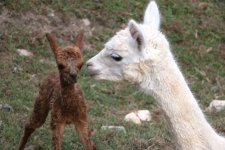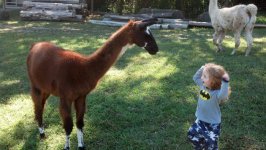I am sure the alpacas will appreciate it, but it will be easy to know if the llamas are enjoying it... if they are spitting, time to move... lol
So far none of mine have had a single objection to any type of music I've played by the barn, bad harmonica, faltering bugle, discordant guitar.
But a little about spitting if anyone is interested ...

I've had both llamas and alpacas here (known as "camelids", collectively, along with camels and a few others) for a long time and know a lot of people who have them at their farms. I also volunteer when needed with the llama rescue organization, catch and haul surrendered and confiscated animals, and move them on occasion to new homes, sometimes 100s of miles.
Llamas and alpacas are by nature curious, gentle, and non-aggressive, although not typically approachable - they "know how long a person's arm is". They naturally don't pull, lunge, buck, kick, bite - not at all dangerous like an untrained horse! While usually impossible to approach and catch in a field, once haltered they are "instantly domesticated." I can put a halter on a 400 lb llama and a two-year-old can lead them around. But like other animals, much depends on how they are trained, especially how handled when very young.
This alpaca Nika is unusually approachable,
probably due of the way I handled her the first few days after birth.

Nika at one hour old:

The mothers are surprisingly tolerant when I handle babies! Of course, they have already learned to trust me.
But llamas do have a bad reputation for spitting, much of it undeserved. (And alpacas will spit too if provoked or abused!)
However, none of them normally spit at people.
They will spit at each other over things like
- "I'm the boss, no, I'm the boss"
- "I want that food. That's my food", and
- "Get away from my girlfriend"
However, before any spitting they typically give several warning signs:
1) pin their ears back, like horses ("I am upset")
2) put their nose up in the air ("I threaten you, back off")
3) regurgitate stomach contents into their mouth, at which point they are locked and loaded, ready to fire.
If one backs down they both swallow the stuff and get back to what they were doing.
A person may be spit upon accidentally if they happen to be in the way! Since llamas have multiple stomachs and chew their cud, the spit consists of partially digested stomach contents. Kind of nasty smelling.
Llamas and alpacas appear to hate to spit. It must leave a nasty taste in their mouths since for 20 minutes or so they stand around with their mouths open, lower lip hanging low, and dripping, apparently mouth-breathing. By this I can always tell which two just had a disagreement!
Llamas and alpaca will spit if tormented. I visited a farm once where the owners mistreated them and some were hair-trigger spitters. They also don't like people intruding on their space and have been known to spit when pressed in by too many people. And I think some are simply not raised and handled properly.
A wild llama may spit if constrained. I once bought a mother to get the 1-month-old baby and she had NEVER been handled. The guy forced her into a tight spot and wrestled a halter on her for the first time. When I got her to the farm I noticed she had a tick near her nose. I guided her in a tight "catch pen" and managed to get a rope around her head to hold her still enough to remove the tick. Took me over an hour. She was a serial spitter - I had to wear a face shield to get close enough! (After working with her a couple of years she became very tame and gentle and NEVER spit again!)
Oh, llamas and dogs (and coyotes) are natural enemies. Llamas will make an alarm call when a strange canine is near, if one got inside the fence they would easily kill it.
This is little Nika from excellent pedigreed parents:

My first llama Bubinga,

Always a hit at the Christmas parades!

Ok, this is way more than I intended to write. I'll put all my camelids in a tight pen and experiment with playing some horrible accordion music and report back!
JKJ






